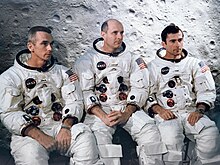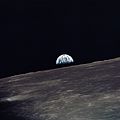Apollo 10: Difference between revisions
No edit summary |
added blurb about purpose of mission |
||
| Line 19: | Line 19: | ||
}} |
}} |
||
'''Apollo 10''' was the fourth manned mission in the [[Apollo program]]. The mission included the second crew to orbit the Moon and an all-up test of the [[Apollo Lunar Module|lunar module]] (LM) in lunar orbit. The LM came to within 8.4 [[nautical mile]]s (15.6 km) of the lunar surface during practice maneuvers. |
'''Apollo 10''' was the fourth manned mission in the [[Apollo program]]. Its purpose was to be a "dry run" for the Apollo 11 mission, testing all of the procedures and components of a moon landing without actually landing on the moon itself. The mission included the second crew to orbit the Moon and an all-up test of the [[Apollo Lunar Module|lunar module]] (LM) in lunar orbit. The LM came to within 8.4 [[nautical mile]]s (15.6 km) of the lunar surface during practice maneuvers. |
||
According to the 2001 [[Guinness World Records]] Apollo 10 set the record for the highest speed attained by a manned vehicle at 39,897 km/h (11.08 km/s or 24,791 mph). The speed record was set during the return from the Moon on May 26, 1969. |
According to the 2001 [[Guinness World Records]] Apollo 10 set the record for the highest speed attained by a manned vehicle at 39,897 km/h (11.08 km/s or 24,791 mph). The speed record was set during the return from the Moon on May 26, 1969. |
||
Revision as of 17:27, 6 October 2009
| COSPAR ID | 1969-043A |
|---|---|
| SATCAT no. | 03941 |
| Mission duration | 8 d 00 h 03 m 23 s |
| Start of mission | |
| Launch date | May 18, 1969 16:49:00 UTC |

 | |
Apollo 10 was the fourth manned mission in the Apollo program. Its purpose was to be a "dry run" for the Apollo 11 mission, testing all of the procedures and components of a moon landing without actually landing on the moon itself. The mission included the second crew to orbit the Moon and an all-up test of the lunar module (LM) in lunar orbit. The LM came to within 8.4 nautical miles (15.6 km) of the lunar surface during practice maneuvers.
According to the 2001 Guinness World Records Apollo 10 set the record for the highest speed attained by a manned vehicle at 39,897 km/h (11.08 km/s or 24,791 mph). The speed record was set during the return from the Moon on May 26, 1969.
While not included in the official mission logo, due to the use of their names only as callsigns, the Peanuts characters Charlie Brown and Snoopy became semi-official mascots for the mission.[2][3] Peanuts creator Charles Schulz also drew some special mission-related artwork for NASA.
Crew
| Position | Astronaut | |
|---|---|---|
| Commander | Thomas P. Stafford Third spaceflight | |
| Command Module Pilot | John W. Young Third spaceflight | |
| Lunar Module Pilot | Eugene A. Cernan Second spaceflight | |
Backup crew
| Position | Astronaut | |
|---|---|---|
| Commander | Gordon Cooper, Jr | |
| Command Module Pilot | Donn Eisele | |
| Lunar Module Pilot | Edgar Mitchell | |
Support crew
Flight directors
- Glynn Lunney, Black team
- Gerry Griffin, Gold team
- Milton Windler, Maroon team
- Pete Frank, Orange team
Crew notes
By the normal rotation in place during Apollo, the backup crew would have been scheduled to fly on Apollo 13. However, Alan Shepard was given the command slot instead. Cooper was enraged and resigned from NASA. Later, Shepard's crew was forced to switch places with Jim Lovell's tentative Apollo 14 crew.[4]
However, Deke Slayton recollected in his memoirs that Cooper and Eisele were never intended to rotate to another mission as both were out of favor with NASA management for various reasons (Cooper for his lax attitude towards training and Eisele for incidents aboard Apollo 7 and an extra-marital affair) and were assigned to the backup crew simply because of a lack of qualified manpower in the Astronaut Office at the time the assignment needed to be made. Cooper, Slayton noted, had a very small chance of receiving the Apollo 13 command if he did an outstanding job with the assignment, which he didn't. Eisele, despite his issues with management, was always intended for future assignment to the Apollo Applications Program (which was eventually cut down to only the Skylab component) and not a lunar mission.[5]
Mission parameters
- Mass: CSM 28,834 kg; LM 13,941 kg
Earth orbit
- Perigee: 184.5 km
- Apogee: 190 km
- Inclination: 32.5°
- Period: 88.1 min
Lunar orbit
- Perilune: 111.1 km
- Apolune: 316.7 km
- Inclination: 1.2°
- Period: 2.15 hours
LM - CSM docking
- Undocked: May 22, 1969 - 19:00:57 UTC
- Redocked: May 23, 1969 - 03:11:02 UTC
LM closest approach to lunar surface
- May 22, 1969, 21:29:43 UTC
On May 22, 1969 at 20:35:02 UTC, a 27.4 second LM descent propulsion system burn inserted the LM into a descent orbit of 112.8 km by 15.7 km so that the resulting lowest point in the orbit occurred about 15° from lunar landing site 2 (the Apollo 11 landing site). The lowest measured point in the trajectory was 15.6 km above the lunar surface at 21:29:43 UTC.
Mission highlights
This dress rehearsal for a Moon landing brought Stafford and Cernan's lunar module Snoopy to 8.4 nautical miles (15.6 km) from the lunar surface. Except for that final stretch, the mission went exactly as a landing would have gone, both in space and on the ground, where Apollo's extensive tracking and control network was put through a dry run.
Shortly after leaving low Earth orbit, the command/service module separated from the S-IVB stage, turned around, and docked its nose to the top of the lunar module still nestled in the S-IVB. The CSM/LM stack then separated from the S-IVB for the trip to the moon.
Upon reaching lunar orbit, Young remained alone in command module Charlie Brown while Stafford and Cernan flew separately in the LM. The LM crew checked out their craft's radar and ascent engine, rode out a momentary gyration in the lunar lander's motion (due to a faulty switch setting), and surveyed the Apollo 11 landing site in the Sea of Tranquility. The lunar module on this flight was not equipped to land, however.
Apollo 10 added another first by broadcasting live color TV from space.
Hardware disposition
The Apollo 10 LM ascent stage is in heliocentric orbit making it the sole intact lunar module ascent stage remaining out of the 10 true LMs sent into space. The Apollo 5, 9 and 13 LM ascent stages burned up in Earth's atmosphere, the Apollo 11 and 16 LM ascent stages were left in lunar orbit and crashed onto the moon when their orbits decayed, and the Apollo 12, 14, 15 and 17 LM ascent stages were deliberately crashed onto the moon in order to obtain seismic readings from the seismometers placed on the lunar surface. (The Lunar Test Article LTA-B flown as ballast aboard Apollo 8 remained attached to the Saturn S-IVB stage that went into solar orbit.)
The Apollo 10 LM descent stage is expected to have crashed onto the lunar surface, but the exact location is unknown.
The Apollo 10 Command Module Charlie Brown is currently on loan to the Science Museum in London, where it is on display.
Mission insignia
The shield-shaped emblem for the flight shows a large, three-dimensional Roman numeral X sitting on the moon's surface, in Stafford's words, "to show that we had left our mark." Although it did not land on the moon, the prominence of the number represents the significant contributions the mission made to the Apollo program. A CSM circles the moon as an LM ascent stage flies up from its low pass over the lunar surface. The earth is visible in the background. A wide, light blue border carries the word APOLLO at the top and the crew names around the bottom. The patch is trimmed in gold. The insignia was designed by Allen Stevens of Rockwell International.[6]
Images
-
The S-IC first stage in the VAB
-
Apollo 10 during rollout (NASA)
-
CSM "Charlie Brown" (NASA)
-
Apollo 10 view of Earth rise. (NASA)
-
The crew poses with their launch vehicle. Left to right, Cernan, Young, Stafford.
-
Crew boarding the command module before launch
-
Recovery by a SH-3D of HS-4 from USS Princeton
-
The Command Module, photographed in December 2007.
-
The Command Module, at London Science Museum (May 2009).
-
The Command Module, at London Science Museum (May 2009).
See also
Notes
- ^ Richard W. Orloff. "Apollo by the Numbers: A Statistical Reference (SP-4029)". NASA.
- ^ http://science.ksc.nasa.gov/mirrors/images/images/pao/AS10/10075138.jpg
- ^ http://science.ksc.nasa.gov/mirrors/images/images/pao/AS10/10075088.jpg
- ^ Chaikin, pp. 347-48
- ^ Donald K. Slayton, "Deke!" (New York: Forge, 1994), 236
- ^ Hengeveld, Ed (May 20, 2008). "The man behind the Moon mission patches". collectSPACE. Retrieved 2009-07-18.
References
- NASA NSSDC Master Catalog
- APOLLO BY THE NUMBERS: A Statistical Reference by Richard W. Orloff (NASA)
- Apollo 10 Characteristics - SP-4012 NASA HISTORICAL DATA BOOK
- Lattimer, Dick (1985). All We Did was Fly to the Moon. Whispering Eagle Press. ISBN 0-9611228-0-3.
- Chaikin, Andrew (2007). A Man on the Moon, Penguin Books, ISBN 978-0-14-311235-8.










